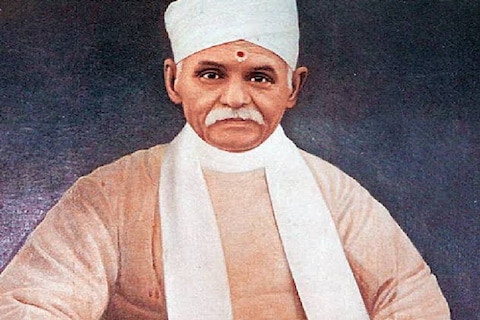 |
| IMAGE CREDIT-NEWS18.COM |
Biography of Mahamana Madanmohan Malviya 2022
Malviya Ji was born on 25 December 1861 in Allahabad (today's Prayagraj). His father was Pt. Brajnath and mother's name was Moonadevi. His ancestors came from Malwa and settled in Prayag. His father used to feed the family by narrating the story of Shrimad Bhagwat. He was a great scholar of Sanskrit. His wife's name was Kundan Devi. Inspired by his father, Malaviya ji also became interested in the Sanskrit language and that is why Malaviya Ji's father got him admitted to Pt. Hardev Ji's school.
Points Information
Name
Madanmohan Malviya
Date of birth
25 December 1861
Age
70 years
Birth place
Prayagraj (Allahabad), Uttar Pradesh
Father's name
Pt. Brajnath
Mother's name
Moonadevi
Wife name
Kundan Devi
Profession
Freedom Fighter, Politician
Children
Not Known
Death
12 November 1946
Death Place
Place Allahabad
Siblings
7 Siblings
Award
Bharat Ratna 2014
Place Allahabad
Education of Madan Mohan Malviya
After passing the primary examination from there, he was sent to another school run by Vidyavardhini Sabha. After getting an education here, he started teaching in a school in Allahabad and while staying there, he started writing poems under the name 'Makrand'. In 1879, he passed the 10th examination from Muir Central College, and on getting a scholarship, he completed his B.A. from the University of Calcutta. He wanted to do an MA in Sanskrit, but his family circumstances did not allow it. His father wanted him to take up his family profession by reciting Shrimad Bhagwat.
The political career of Madan Mohan Malviya
In December 1886, Malaviya attended the Second Indian National Congress session in Calcutta under the chairmanship of Dadabhai Naoroji.
After finishing his law degree, he began practicing law at the Allahabad District Court in 1891 and moved to the Allahabad High Court by December 1893.
Malviya became the President of the Indian National Congress in 1909 and 1918. He was a moderate leader and opposed separate electorates for Muslims under the Lucknow Pact of 1916.
He remained a member of the Imperial Legislative Council from 1912 until 1926 when it was converted into the Central Legislative Assembly in 1919. Malviya was an important figure in the non-cooperation movement. However, he was opposed to the politics of Khilafat and the involvement of Congress in the Khilafat movement.
In 1928 he joined Lala Lajpat Rai, Jawaharlal Nehru, and many others in opposing the Simon Commission, which was set up by the British to consider the future of India.
During the Civil Disobedience Movement, he was arrested along with 450 other Congress volunteers in Delhi on 25 April 1932, a few days later in 1932 he was appointed as the President of Congress in Delhi after the arrest of Sarojini Naidu. In 1933, in Calcutta, Malviya was again appointed as the President of the Congress. Thus before independence, Malaviya was the only leader of the Indian National Congress to be appointed as its president for four terms.
In protest against the communal award, which demanded a separate constituency for minorities, Malviya left the Congress along with Madhav Srihari Ani and started the Congress Nationalist Party. The party contested the 1934 elections to the central legislature and won 12 seats.
He also brought out many newspapers – Abhyudaya, Leader, Maryada, etc. He was a supporter of ancient culture, he always followed Sanatan Dharma. He contributed to the development of Hindi and boycotted many social evils. Along with this, he also helped in the establishment of Kashi Nagari Pracharini Sabha. He actively participated in the non-cooperation movement along with Gandhiji.
Death of Madan Mohan Malviya
While engaging in many such works, Mahamana ji, who was always ready to serve society, died in Allahabad on November 12, 1946. Even today the indelible impression of his commendable works is present in the hearts of us Indians. Posthumously, in 2014, Mahamana was awarded the Bharat Ratna.
FAQ
Q-Brief General Knowledge of Madan Mohan Malviya
Name- Madan Mohan Malaviya
Surname- Mahamana
Date of Birth 25 December 1861
Place of Birth Allahabad, Uttar Pradesh (India)
Date of Death 12 November 1946
Q-When did Pandit Madan Mohan Malviya die?
12 November 1946
Q-What was founded by Madan Mohan Malviya?
BHU was founded by Madan Mohan Malviya.
Q-Who gave the title Mahamana
'Mahamana' was a title given by Nobel laureate Rabindranath Tagore for his skill in doing various aspects of his life with ease and grace.
Q-Who was the mentor of Madan Mohan Malviya?
Mahamana's father was a great scholar of the Sanskrit language. At the age of just 5 years, his parents admitted him to Pandit Hardev Dharma Gyanopadesh Pathshala to get him elementary education in the Sanskrit language. Mahamana passed the primary examination from there.
Q-How many acres is BHU in?
BHU is situated on the southern bank of Varanasi, on the banks of the river Ganges. Development of the main campus spread over 1,300 acres (5.3 km2) on land donated by the then Kashi Naresh Prabhu Narayan Singh in 1916.
Q-What was the main slogan of Malvi ji?
It was Malviya Ji who popularized the slogan 'Satyamev Jayate'.


